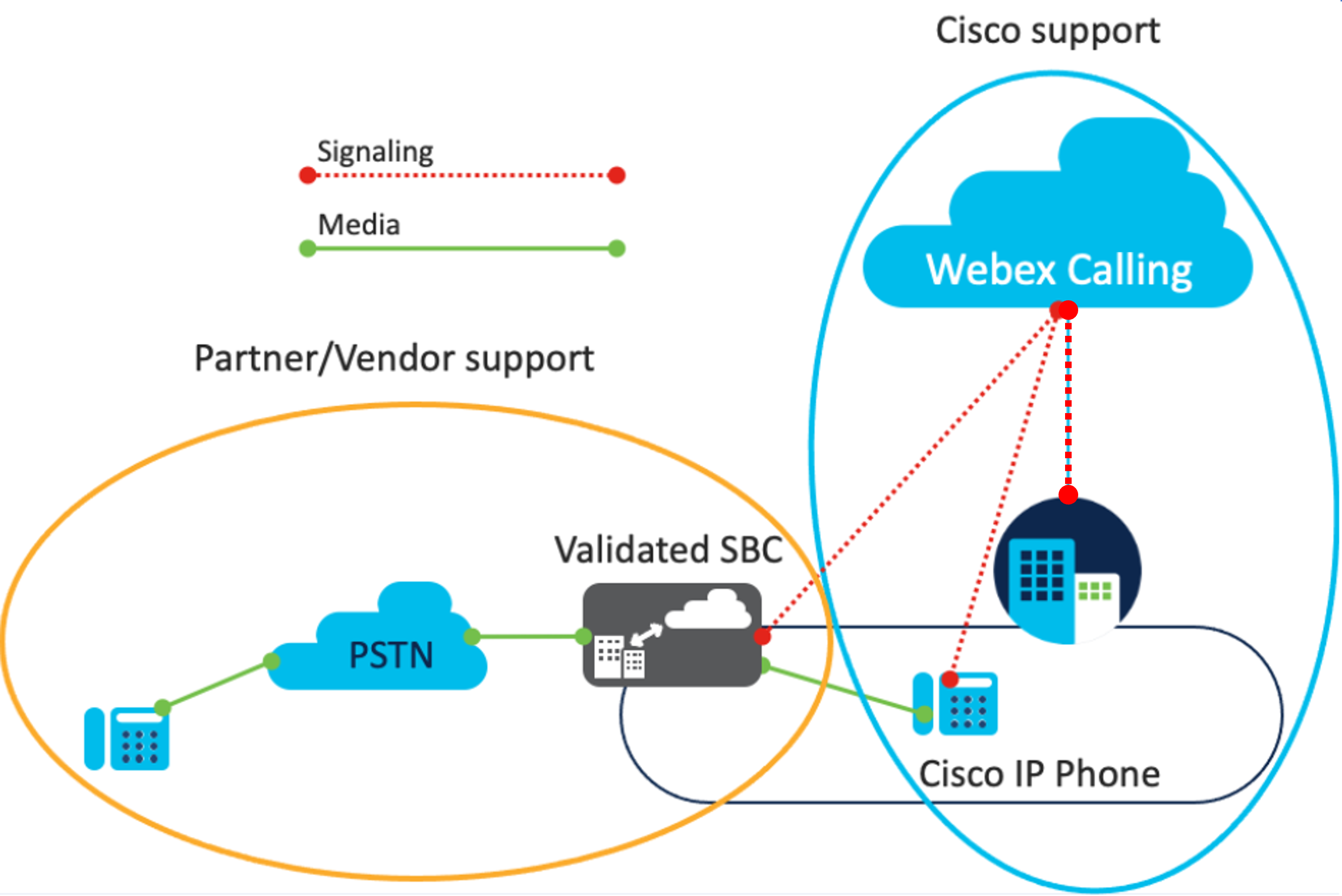- 主页
- /
- 文章


本地网关入门
 在此文章中
在此文章中 反馈?
反馈?本文为管理员提供了设置、维护和排除 本地网关故障所需的所有信息和参考资料。
本地网关可帮助您按自己的节奏迁移到 Webex Calling。本地网关将您现有的本地部署与 Webex Calling 集成。您也可以使用现有的PSTN连接。
在配置 Webex Calling 的本地网关之前,请确保以下事项:
-
了解 VoIP(例如 SIP 和媒体协议)并具备进行基本故障排除的能力。
-
对配置为本地网关的设备(会话边界控制器)有实际的了解。
-
操作会话边界控制器所需的许可证。
-
了解部署在您公司内部并配置为与 Webex Calling 配合使用的 Cisco Unified Communications Manager (Unified CM) 或同等 PBX。(在与本地环境集成的情况下。)
以下文章可以帮助您熟悉部署选项:
|
术语 |
引用 |
|---|---|
|
干线和路由组 |
有关更多信息,请参阅 [ Webex Calling Preferred Architecture中的 trunks 和路由组 。 |
|
自带PSTN、企业拨号 |
代表自带PSTN网络。有关更多信息,请参阅 PSTN 接入和本地互连 在 Webex Calling Preferred Architecture中。 |
|
互联网接入 (OTT)、Webex Edge Connect |
本地网关中继模型
本地网关中继模型有两种类型:
-
基于注册的中继
-
基于证书的中继
这些型号的功能类似,但在规模和设备支持方面有所不同。选择符合您需求的合适干线型号。
|
功能性 |
基于注册 |
基于证书 |
|---|---|---|
|
并发调用 |
每个中继线最多可同时进行 250 个呼叫。 |
并发调用 > 每箱250。 |
|
设备类型 |
仅支持 Cisco Unified Border Element (CUBE)。 有关更多信息,请参阅 CUBE 平台支持。 |
表中列出了可供选择的设备类型 支持基于证书的中继的设备类型。 |
|
身份验证模型 |
基于摘要的身份验证模型,依赖于共享的用户名和密码来验证注册和调用。 有关更多信息,请参阅 基于注册的主干。 |
基于证书的身份验证,并采用LGW FQDN验证。 有关更多信息,请参阅 基于证书的主干。 本地网关向 Webex Calling 云发起的每个 SIP 事务都应包含带有本地网关 FQDN 的 Contact 标头。 选项:来自本地网关的交易对于控制中心中的本地网关状态保持在线尤为重要。 |
|
网络、防火墙和NAT要求 有关入口和出口流量的详细信息,请参阅 Cisco Webex Calling 端口参考信息。 |
任何NAT或公网IP。动态NAT更受欢迎,因为它设置更简单,需要的防火墙配置也更少。 需要防火墙允许入站和出站流量(Webex 呼叫本地网关,反之亦然)。 对于入站流量,防火墙会根据出站注册消息打开入站端口。 建议对所有 Webex Calling IP 地址和端口进行针孔开孔。它并非特定于本地网关注册的 IP 地址或端口。 |
面向公共互联网的网络,包括公共 IP 地址或静态 NAT。 需要防火墙允许入站和出站流量(Webex Calling 到本地网关以及反之亦然)。 |
|
公共 DNS 服务要求 |
公共 DNS 服务无需任何特殊配置。 |
|
|
CA 和证书要求 |
|
|
|
使用云连接器进行注册和故障排除 |
支持自动排查配置问题。 |
不支持自动排查配置问题。 |
支持的会话边界控制器
在 Webex for Government 中为本地网关配置基于证书的中继。此外,CUBE 是目前唯一支持 Webex for Government 的会话边界控制器 (SBC)。
|
单板计算机供应商和型号 |
最低版本 |
公开警告 |
Webex for Government |
|---|---|---|---|
|
Cisco—CUBE 型号列于 路由器平台支持 |
Cisco IOS XE Bengaluru 17.6.1a 要将本地网关配置为 Cisco SD-WAN 解决方案中的控制器模式,请使用 Cisco IOS XE Cupertino 17.7.1 或更高版本。 有关推荐版本,请参阅 Cisco 软件研究 页面。搜索平台并选择“推荐”版本之一。 |
Cisco ISR 1100 平台不支持配置验证。 对于以控制器模式部署的 Cisco SD-WAN 网关,不支持以下功能:
|
Webex for Government 不支持基于注册的中继。 |
|
单板计算机供应商和型号 |
最低版本 |
公开警告 |
Webex for Government |
|---|---|---|---|
|
Cisco—CUBE 型号列于 路由器平台支持 |
思科 IOS XE 库比蒂诺 17.9.1a 有关推荐版本,请参阅 Cisco 软件研究 页面。搜索平台并选择“推荐”版本之一。 |
对于以控制器模式部署的 Cisco SD-WAN 网关,不支持以下功能:
|
支持 |
|
Oracle—AP系列 |
9.0.0 |
ICE互操作性的局限性。请参阅 Cisco Webex - Oracle SBC 与 Cisco Webex Calling 作为第三方本地网关 (LGW) 集成 解决方案文档中的第 9 节。 |
不支持 |
|
Oracle—VME |
9.0.0 |
ICE互操作性的局限性。请参阅 Cisco Webex - Oracle SBC 与 Cisco Webex Calling 作为第三方本地网关 (LGW) 集成 解决方案文档中的第 9 节。 |
不支持 |
|
Oracle——Oracle SBC 公有云 |
9.0.0 |
ICE互操作性的局限性。请参阅 Cisco Webex - Oracle SBC 与 Cisco Webex Calling 作为第三方本地网关 (LGW) 集成 解决方案文档中的第 9 节。 |
不支持 |
|
AudioCodes—Mediant CE & VE |
7.40A.250.440 |
ICE互操作性的局限性。请参阅 连接 Webex Calling 与 AudioCodes SBC 配置说明的第 2.4.2 节 。 |
不支持 |
|
AudioCodes—Mediant Appliances |
7.40A.250.440 |
ICE互操作性的局限性。请参阅 连接 Webex Calling 与 AudioCodes SBC 配置说明的第 2.4.2 节 。 |
不支持 |
|
色带—SBC 5000 系列、SBC 7000 和 SBC SWe |
10.1 |
ICE互操作性的局限性。请参阅 “注意事项 ”部分。 |
不支持 |
|
丝带—SBC SWe Edge |
11.0.2 |
ICE互操作性的局限性。请参阅 “注意事项 ”部分中的解决方法。 |
不支持 |
|
丝带——SBC 1000、SBC 2000 |
11.0.1 |
ICE互操作性的局限性。请参阅 “注意事项 ”部分中的解决方法。 |
不支持 |
|
丝带—8000 w/SBC 西边 |
25.0 |
请参阅 Ribbon Edge 8000 与 Cisco Webex Calling:Interoperability 指南 注意事项部分。 |
不支持 |
| 任意节点—SBC | 4.10 |
不支持 | |
| Italtel NetMatch-S SBC | NetMatch-S-CI 5.8.0-20240111 | 有关已知限制,请下载 NetMatch-S CI SBC 配置 WEBEX 呼叫 并参阅第 3.3 节注意事项。 |
不支持 |
Webex Calling 支持在 NAT 后部署本地网关。呼叫行为可能取决于网络中使用的 NAT 防火墙类型以及 SBC 提供的功能。
呼叫容量要求
基于注册和基于证书的中继模型具有不同的并发呼叫容量,如下表所示:
|
并发调用要求) |
大约用户数量 |
车架类型偏好 |
最低链路质量 |
|---|---|---|---|
|
~ 2000–6500 |
65000 |
基于证书 |
互连 |
|
~ 250–2000 |
20000 |
基于证书 |
超高流量(OTT) |
|
最多 250 |
2500 |
基于注册 |
奥特 |
连接资格
为确保通话质量始终如一地高,本地网关与 Webex Calling 之间的网络连接应具备以下最高条件:
-
单向延迟 100 毫秒
-
10毫秒数据包抖动
-
丢包率0.5%
有关通话容量的更多信息,请参阅 Webex Calling 的首选架构。
连接模型和要求
-
在配置过程中,每个本地网关都会被分配到两个 Webex Media PoP 位置,以确保冗余和高可用性。此任务通过 DNS SRV 记录进行管理。
-
媒体接入点位置是根据网关的地理位置确定的,网关是在控制中心配置过程中配置的。通常情况下,网关会被分配给同一区域内两个最合适、地理位置上分离的媒体接入点。例如,如果网关在欧盟境内部署,则该网关使用欧盟境内的两个媒体接入点。
有关 Webex Media PoP 位置的完整列表,请参阅 Webex Calling 数据中心位置。
Webex Calling 的位置也是媒体接入点。
-
区域媒体功能也适用于网关连接。根据通话场景,媒体文件尽可能保存在本地区域内。
配置本地网关
| 1 |
从控制中心配置中继。 |
| 2 |
配置您的设备以充当本地网关的角色。
|
| 3 |
确认本地网关在控制中心状态中处于活动状态。 有关合作伙伴托管网关的说明,请参阅 配置合作伙伴托管网关
|
Webex Calling 目前不支持在单个 vCUBE 实例上同时运行 CME 和 LGW。
排查本地网关故障
如果本地网关状态未激活或存在其他问题,请在联系支持团队之前参考以下文档:
当本地网关未激活时,请在控制中心检查中继状态:
-
登录到控制中心。
-
前往 。
-
选择要查看状态的后备箱。
-
单击 中继信息。
-
在线— 所有 Webex Calling 边缘代理与本地网关之间已成功连接
-
离线— Webex Calling 与本地网关连接失败
-
受损— 至少一个 Webex Calling 边缘代理与本地网关之间的连接失败
-
未知— 在 Webex Calling 与最近添加的本地网关之间建立连接时
-
有关基于证书的中继或基于注册的中继的中继状态更新,请参阅 配置 Webex Calling 的中继、路由组和拨号计划。
-
有关配置中继警报的更多信息,请参阅控制中心中的 警报中心。
支持第三方本地网关
使用第三方 SBC 部署 Webex Calling 需要 Cisco 和供应商合作伙伴的支持。以下概述了支持详情:
-
Webex Calling 支持:
-
使用 Webex Calling 的 Cisco 或合作伙伴必须与 Cisco 签订支持协议才能获得 Cisco 的协助(TAC 支持)。
-
Cisco 为 Webex Calling 提供边缘部署方面的客户支持,并为 Webex Calling 注册的 Cisco IP 电话提供支持。
-
-
供应商支持:
-
在部署期间,思科为拥有经过验证的第三方 SBC 设备的客户或合作伙伴提供支持,但不负责为实际的 SBC 提供帮助。
-
思科不负责涉及客户和SBC供应商的非思科支持案例。部署过程中出现的问题或软件缺陷可以与 SBC 供应商和思科进行讨论。
-



